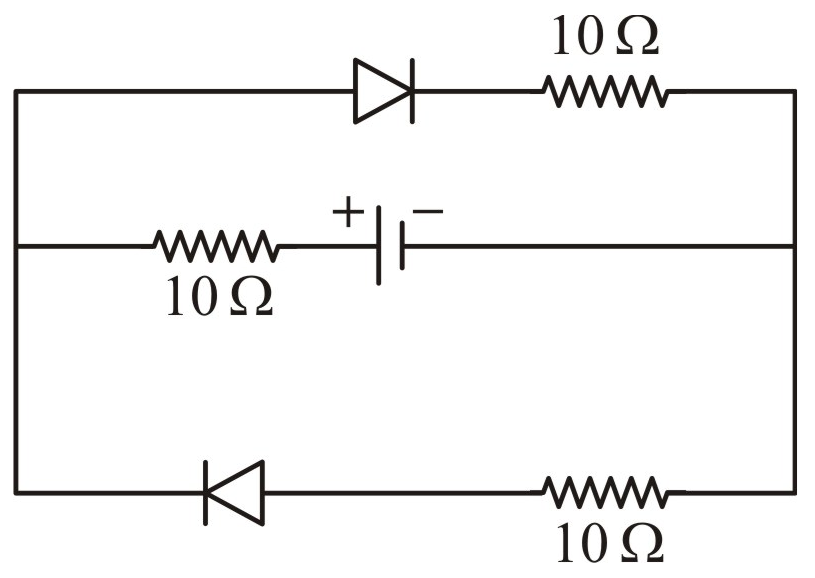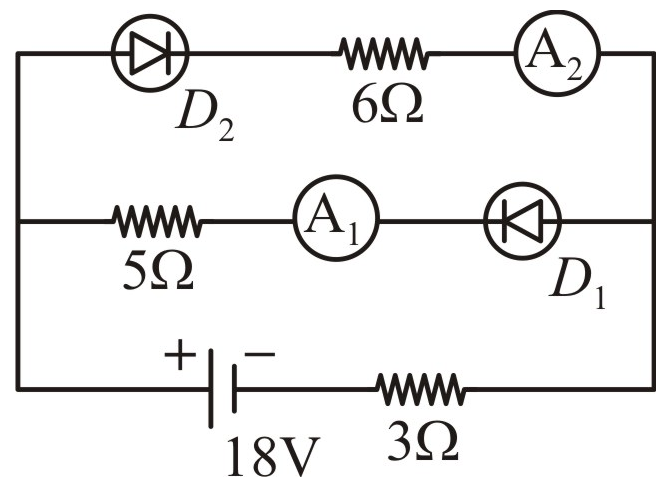In the circuit shown, are respectively:
(If diodes are ideal)

1. 0, 0
2. 5 mA, 5 mA
3. 5 mA, 0
4. 0, 5 mA
(If diodes are ideal)

The depletion layer in the P–N junction region is caused by:
| 1. | the drift of holes |
| 2. | diffusion of charge carriers |
| 3. | migration of impurity ions |
| 4. | drift of electrons |
In the given circuit, PN-junction diodes are ideal. For the following potential of A and B, the correct increasing order of resistance between A and B will be:
i. –10V, –5V
ii. –5V, –10V
iii. –4V, –12V
1. (i) < (ii) < (iii)
2. (iii) < (ii) < (i)
3. (ii) = (iii) < (i)
4. (i) = (iii) < (ii)
The \((I-V)\) characteristics of a \(p-n\) junction diode is as shown. If \(R_1\) and \(R_2\) be the dynamic resistance of the \(p-n\) junction when (i) a forward bias of \(1\) volt is applied and (ii) a forward bias of \(2\) volts is applied respectively, then \(\frac{R_1}{R_2}=?\)
1. \(160\)
2. \(16\)
3. \(1.6\)
4. \(0.16\)
What is the equivalent resistance across the terminals of the battery if the diodes are ideal?
| 1. | \(10~ \Omega\) | 2. | \(20~ \Omega\) |
| 3. | \(15~ \Omega\) | 4. | \({10\over3} ~ \Omega\) |
If in a reverse-biased junction, an increase in carrier concentration takes place due to the creation of new hole-electron pairs by the light of wavelength less than or equal to 620 nm, then the bandgap is:
1. 1 eV
2. 2 eV
3. 20 eV
4. 0.2 eV
What is the reading of the ideal ammeters A1 and A2 connected in the given circuit diagram, if junction diodes are ideal?
1. 2 A and zero
2. 3 A and 2 A
3. 2 A and 3 A
4. Zero and 2 A
In which of the following condition, diffusion current in junction is more than drift current?
| 1. | Forward biasing | 2. | Reverse biasing |
| 3. | No biasing | 4. | All of these |
The net charges on -type semiconductor and -type semiconductor are, respectively:
1. Positive, negative
2. Negative, positive
3. Positive, positive
4. Zero, zero
The given circuit has two ideal diodes connected as shown in the figure below. The current flowing through the resistance R1 will be:
| 1. | 2.5 A | 2. | 10.0 A |
| 3. | 1.43 A | 4. | 3.13 A |







